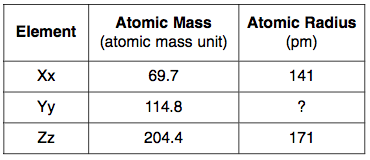Chem Lesson 2.4

These questions deal with trends in atomic radii. look at table S if you have any questions.
- 1.
An atom of which element has the largest atomic radius?
- A.
Fe
- B.
Mg
- C.
Si
- D.
Zn
Correct Answer
B. MgExplanation
Mg is in group 2...as you move to the left of the periodic table, the radii increase.Rate this question:
-
- 2.
Explain, in terms of atomic structure, why the elements in Group 2 have similar chemical properties. [1]
Correct Answer
they have the same valence electrons
same valence electrons
same valence electron
2
2 valence e
2 valence elecctronsExplanation
Same group, same valence electron. Same valence electrons, similar chemical properties.Rate this question:
- 3.
As atomic number increases within Group15on the Periodic Table, atomic radius
- A.
Decreases, only
- B.
Increases, only
- C.
Decreases, then increases
- D.
Increases, then decreases
Correct Answer
B. Increases, onlyExplanation
As atomic number increases within Group 15 on the Periodic Table, the atomic radius increases, only. This is because as you move down the group, each successive element has one more energy level than the previous one. The additional energy level increases the distance between the nucleus and the outermost electron, resulting in a larger atomic radius.Rate this question:
-
- 4.
How do the atomic radius and metallic properties of sodium compare to the atomic radius and metallic properties of phosphorus?
- A.
Sodium has a larger atomic radius and is more metallic.
- B.
Sodium has a larger atomic radius and is less metallic.
- C.
Sodium has a smaller atomic radius and is more metallic.
- D.
Sodium has a smaller atomic radius and is less metallic.
Correct Answer
A. Sodium has a larger atomic radius and is more metallic.Explanation
Sodium is in group 1. GROUP 1 elements have the largest radii of any element in the same period.Rate this question:
-
- 5.
An element that is malleable and a good conductor of heat and electricity could have an atomic number of
- A.
16
- B.
18
- C.
29
- D.
35
Correct Answer
C. 29Explanation
29 is a metal. Metals are malleable (bendable) and they conduct electricity.Rate this question:
-
- 6.
Which list of elements from Group 2 on the Periodic Table is arranged in order of increasing atomic radius?
- A.
Be, Mg, Ca
- B.
Ca, Mg, Be
- C.
Ba, Ra, Sr
- D.
Sr, Ra, Ba
Correct Answer
A. Be, Mg, CaExplanation
Look at the sheet we made in class. As you go down a group, more orbitals are added...the radius increases.Rate this question:
-
- 7.
The elements in Period 5 on the Periodic Table are arranged from left to right in order of
- A.
Decreasing atomic mass
- B.
Decreasing atomic number
- C.
Increasing atomic mass
- D.
Increasing atomic number
Correct Answer
D. Increasing atomic numberExplanation
The Periodic Table is arranged according to atomic number (# of protons). Just to verify this, you can look at the periodic table and notice the atomic mass fluctuates for transition elements (those elements in groups 3-12). The only possible option is INCREASING ATOMIC NUMBER.Rate this question:
-
- 8.
The data table below shows elements Xx, Yy, and Zz from the same group on the Periodic Table. What is the most likely atomic radius of element Yy?
- A.
103 pm
- B.
127 pm
- C.
166 pm
- D.
185 pm
Correct Answer
C. 166 pmExplanation
166 fits in the range of 141 - 171, since Yy has a mass between that of Xx and Zz.Rate this question:
-
Quiz Review Timeline +
Our quizzes are rigorously reviewed, monitored and continuously updated by our expert board to maintain accuracy, relevance, and timeliness.
-
Current Version
-
Mar 22, 2023Quiz Edited by
ProProfs Editorial Team -
Oct 05, 2011Quiz Created by
Ionca
 Back to top
Back to top



